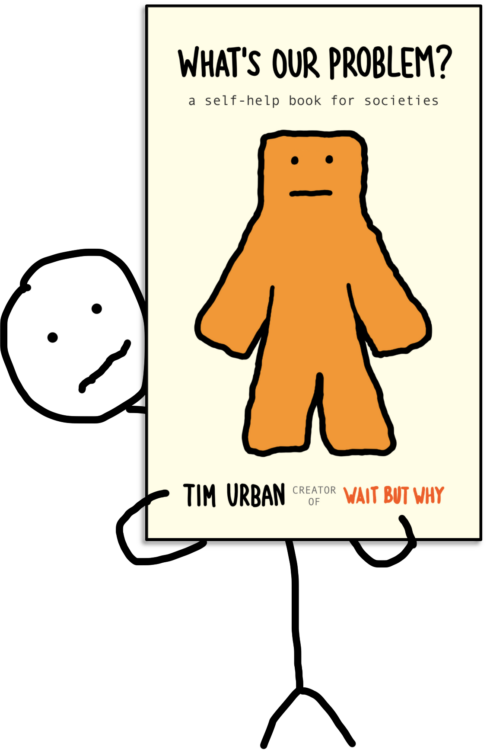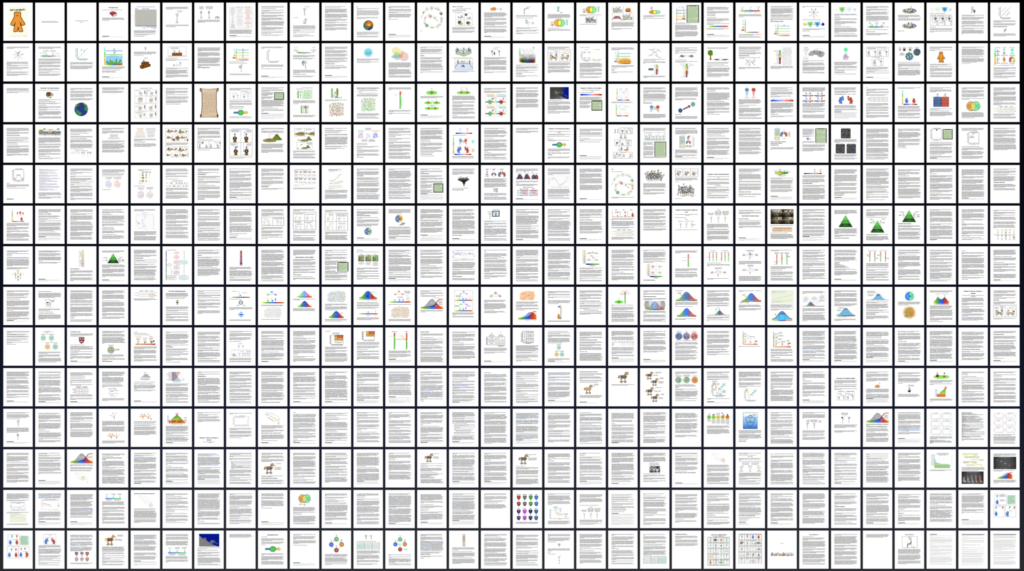What’s our problem?
I highly recommend the Book / Audiobook of What’s Our Problem by Wait But Why’s author Tim Urban.
Michael Kubler: I really liked this book and felt like the topics discussed in it are important for society to understand. Unfortunately it's hard for me to take detailed notes when listening to the audiobook. However Claude (the AI model by Anthropic) is much better at summarisation than I could ever be, so below is a summary based on the book's text. But this is meant as a teaser so you'll go buy the book or listen to the audiobook. There's so much more info in there. I highly recommend it. -------------

The book explores political polarization and division in the United States, particularly around issues of social justice, through the lens of a framework called “The Ladder.” This framework categorizes thinking and culture as high-rung or low-rung. High-rung refers to open, truth-seeking attitudes while low-rung refers to rigid, dogmatic attitudes. The book traces how low-rung thinking and tactics have come to dominate parts of politics, media, and other institutions.
The book continues to use the “Ladder” model to analyze political groups and movements, focusing on case studies of extremism and polarization. It explores the rise of right-wing populism, analyzing factors that allowed more extreme factions to gain power in the Republican Party. It then turns to the left and progressive movements, distinguishing between moderate liberalism and a more dogmatic, illiberal faction the author terms “Social Justice Fundamentalism” (SJF).
Through various examples, the book argues SJF employs coercive ideological tactics akin to a religious fundamentalism. It spreads through institutions via moral justification and accusations of heresy, silencing dissent. The book raises concerns about SJF trends like restrictions on free speech, lack of due process, teaching divisive concepts to children, corporate trainings based on dubious science, and more. It aims to show how SJF differs substantially from mainstream civil rights efforts.
Ultimately the book concludes that extremism and dogmatism from all sides threatens liberal societies by eroding norms of free speech, science, and open debate. It argues self-awareness about our own biases and having the courage to speak up against illiberalism are important to reverse this breakdown of discourse and reason. But it tries to avoid condemning individuals, instead analyzing broad social and psychological patterns that pull groups toward the “lower rungs.”

— Updated and much more detailed summary / explanation based on the newly released Claude 3.0
Here is a summary of the key points from the article:
- Human civilization has been around for 200,000-300,000 years. The past 10,000 years, including all of recorded history, is just a tiny slice of the full human story.
- Technology growth is exponential, meaning it advances faster and faster over time. This makes our current era unprecedented in human history.
- As technology makes humans more powerful, the stakes get higher – both the potential for progress and catastrophic risk are amplified.
- Despite living in prosperous times, modern societies seem to be losing wisdom and devolving into political tribalism and dysfunction at the worst possible time.
- Humans have both a “Higher Mind” – the part that can think rationally and morally – and a “Primitive Mind” driven by instincts and tribalism. There’s a constant tug-of-war between the two.
- Political divisions have collapsed into a single concentrated tribal divide between the Left and Right. Combined with changes in media, geography and social media, this has led to hypercharged tribalism.
- Low-rung political thinking, driven by the Primitive Mind, has taken over both the American Left (“Social Justice Fundamentalism”) and Right (loyalty to Trump over principles).
- In this environment, high-rung political discourse and institutions have been hijacked by illiberal authoritarian tactics – cancel culture, forced ideological training, idea suppression.
- We’re in a dangerous downward spiral as the “high-rung immune system” fails and low-rung politics takes over society’s vital organs. But it’s not too late to reverse course.
- The solution is more awareness of these dynamics and more courage to stand up for liberal Enlightenment values over tribal politics. If enough people do this, societies can self-correct.
More detail on the distinction between low-rung and high-rung political thinking, and how to identify low-rung thinking on both the political Left and Right.
The author uses a “Ladder” metaphor to distinguish between different levels of political discourse:
High-rung thinking (top of the ladder):
- Sees truth-seeking as the highest value
- Treats ideas as hypotheses to be tested and debated
- Encourages viewpoint diversity and independent thought
- Values humility, uncertainty, and changing one’s mind based on evidence
- Applies principles and moral standards consistently regardless of tribe
Low-rung thinking (bottom of the ladder):
- Holds certain ideas as sacred and immune from criticism
- Treats disagreement as dangerous and immoral
- Enforces conformity and ideological homogeneity
- Displays certainty in its worldview and reluctance to change based on evidence
- Applies principles and moral standards selectively based on tribal loyalty
On the political Right, low-rung thinking manifests as:
- Unquestioning loyalty to Donald Trump and his claims, even when they undermine democratic norms (like denying the legitimacy of elections)
- Spreading conspiracy theories and disinformation within insular conservative media bubbles
- Vilifying the Left as an existential enemy and using dehumanizing rhetoric
- Cracking down on teaching about racism in schools in a sweeping way that chills speech
On the political Left, low-rung thinking takes the form of “Social Justice Fundamentalism” (SJF):
- A rigid orthodoxy around identity politics and power dynamics as the root of all issues
- Seeing society as a battle between monolithic identity groups rather than complex individuals
- “Concept creep” that expands the definition of harm and makes heterodox ideas “dangerous”
- Illiberal tactics like cancel culture, compelled speech, and intellectual conformity in institutions
- Double standards and guilt-by-association based on identity group power dynamics
In both cases, low-rung thinking is characterized by:
- Certainty in its worldview as THE truth and intolerance of nuance or dissent
- Punishing and ostracizing in-group dissenters as traitors or heretics
- Subordinating truth-seeking to tribal loyalty and political power struggle
- Expanding aggressively and coercively into institutions rather than by persuasion
By contrast, high-rung thinking approaches contentious issues with greater nuance, humility, openness to debate, consistency of principles and allowance for heterodox views. It tries to balance important values in tension rather than collapsing everything to a single tribal axis.
Identifying low-rung thinking is important because it short-circuits society’s ability to think clearly, negotiate and solve problems. When low-rung tactics hijack institutions and norms, it leads to a downward spiral of tribalism, animosity and dysfunction.
The solution is to recognize low-rung dynamics on “our own side”, stand up consistently for classically liberal Enlightenment norms of open discourse, and have the courage to dissent from tribal orthodoxies in favor of good-faith truth-seeking. This can help societies escape polarized “political Disney World” and preserve a functional political center.
Social Justice Fundamentalism (SJF) is a term coined by the author to describe an ideology and set of tactics that have emerged in recent years, primarily on the political Left. While SJF is rooted in noble goals of addressing social injustice, the author argues that it has morphed into an illiberal and authoritarian force that is damaging to social progress, intellectual discourse, and liberal values.
Key tenets of SJF ideology:
- Society is fundamentally defined by identity group power dynamics and “systems of oppression”. All issues are viewed through this lens rather than considering other factors.
- People are categorized into monolithic identity groups based on race, gender, sexuality, etc. Group membership determines one’s level of “privilege” or “oppression”.
- Disparities between identity groups are seen as prima facie proof of systemic oppression. Explanations that don’t fit this model (e.g. personal agency, cultural differences) are dismissed.
- Heterodox ideas and dissent from SJF tenets are framed as “dangerous” and “harmful”, even a form of “violence”. Disagreement is conflated with the most extreme forms of bigotry.
- Liberal principles like free speech, individualism, and objectivity are seen as mere veils for dominant group power rather than important values.
SJF ideology has roots in neo-Marxist critical theory, postmodernism, and critical race theory from academia. These ideas, while worth engaging, become toxic when wielded as dogma immune from questioning.
Even more concerning are the illiberal and authoritarian tactics used to spread SJF:
- Moral grandstanding and competitive victimhood based on identity group status. Dissent is cast as evil bigotry and met with outrage rather than argument.
- Emotionally manipulative redefinition of terms like “racism” and “harm” to smuggle in fringe ideas as obvious mainstream truths. Motte-and-bailey rhetorical tricks.
- Guilt-by-association attacks, mob pressure, and character assassination to punish dissent and make heterodox opinions radioactive. Coercive self-censorship.
- Struggle sessions, loyalty oaths, and compelled speech to enforce ideological conformity. Accusations require ritual apologies; nuance is not allowed.
- Concept creep and ever-escalating sensitivity to “harm” as a tool to expand the SJF narrative into more domains and slam the Overton window shut.
- Trojan Horse tactics to infiltrate and hijack institutions using SJF language, then transform them from within into SJF organs once a foothold is secured.
When these dynamics take over institutions, they create a self-perpetuating cycle where nuanced discussion is punished, SJF tenets harden into dogma, and those who notice the problems are intimidated into silence. Over time, the institution loses its ability to perceive reality clearly and pursue its original mission.
SJF has had a chilling effect on academia, newsrooms, creative fields, corporations and other important sectors. Well-intentioned people, especially progressives, are told that SJF is synonymous with opposing bigotry; many embrace it for that reason. But the ideology’s flaws and the collateral damage of its tactics make it a dangerous force that is hard to resist once it gains power.
Perversely, SJF often ends up hurting the marginalized groups it claims to defend. It promotes a disempowering victimhood narrative, deprives them of unsanitized discourse, and provokes backlash that fuels the alt-right. SJF also distracts from and discredits more levelheaded efforts to combat social injustice.
The solution is for liberals and progressives to uphold liberal Enlightenment values, even against illiberal forces on “their own side”. This requires understanding SJF’s flaws, resisting its guilting tactics, and having the courage to dissent and support open discourse. With enough awareness and principled resistance, SJF can be countered so that social progress can happen in a healthier way.
You can get the book at https://waitbutwhy.com/whatsourproblem
I’m not affiliated with the book or author, the link isn’t some referral scheme. If you read the summary, you’d know that what is covered in the book is a fight to keep higher rung thinking. To keep society from devolving. Something I certainly don’t want to happen given my Abundant Mars podcast.

